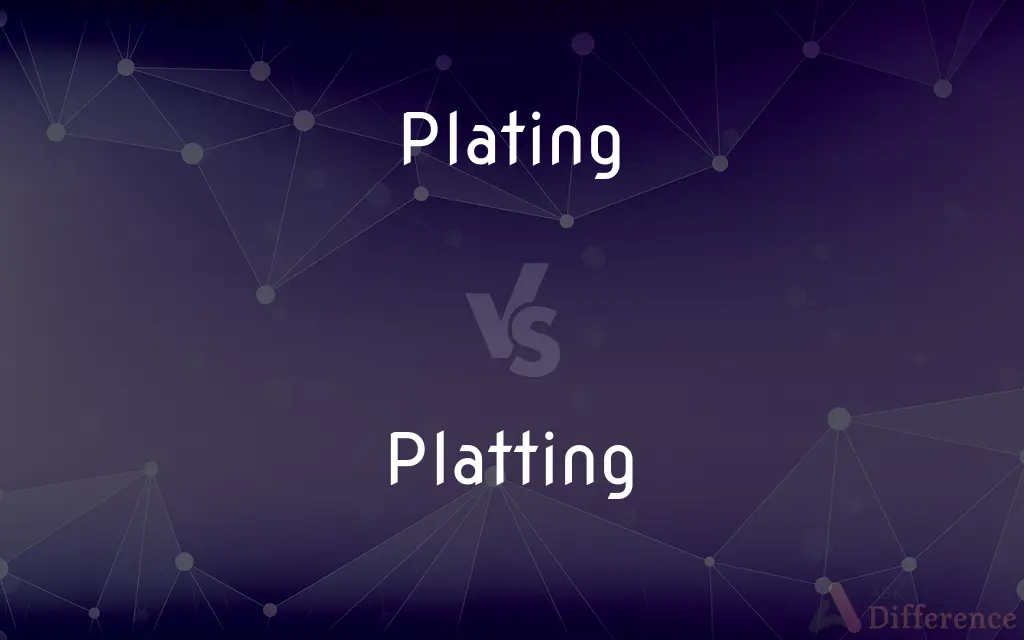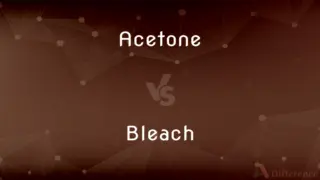Plating vs. Platting — What's the Difference?
By Urooj Arif & Fiza Rafique — Updated on March 28, 2024
Plating involves applying a metal layer to a surface for protection or aesthetics, while platting refers to the process of creating a plat, a map outlining land divisions.

Difference Between Plating and Platting
Table of Contents
ADVERTISEMENT
Key Differences
Plating is a process used in manufacturing and jewelry making, where a thin layer of metal is applied to a surface. This can be for decorative purposes, corrosion resistance, or to improve wear and electrical conductivity. On the other hand, platting is a term primarily used in surveying and real estate, involving the drawing of a plat, a detailed map showing the division of land into plots.
While plating enhances the physical properties of an object, such as durability and appearance, platting is focused on the legal and planning aspects of land use. Plating can involve various techniques like electroplating, where an electric current deposits metal onto an object, whereas platting requires knowledge of local zoning laws, surveying, and drafting to accurately divide and describe land parcels.
In terms of materials, plating typically uses metals like gold, silver, copper, or nickel. Platting, however, deals with documentation and does not involve physical materials in the same sense, relying instead on accurate measurements and legal descriptions to create a plat.
The industries affected by plating and platting also differ significantly. Plating is crucial in manufacturing, electronics, and jewelry, impacting product quality and longevity. Platting, in contrast, is vital in real estate development, land sale transactions, and urban planning, affecting land use and ownership.
The skills required for successful plating include chemical knowledge, precision in applying the metal layer, and understanding of the desired outcome's technical requirements. Platting, however, requires expertise in surveying, understanding of legal land descriptions, and the ability to navigate municipal regulations and zoning laws.
ADVERTISEMENT
Comparison Chart
Definition
Applying a metal layer to a surface.
Creating a map showing land divisions.
Purpose
Enhance durability, appearance, or electrical conductivity.
Detail land divisions for legal and planning purposes.
Techniques
Electroplating, chemical plating.
Surveying, drafting, legal documentation.
Materials Involved
Metals like gold, silver, nickel.
Maps, legal descriptions, survey data.
Relevant Industries
Manufacturing, jewelry, electronics.
Real estate, urban planning, surveying.
Compare with Definitions
Plating
In electronics, creating a conductive surface layer.
Copper plating is used on circuit boards for better electrical connectivity.
Platting
A surveying process to divide land into plots.
Platting the farmland helped in its valuation for sale.
Plating
A method for altering surface properties.
Chrome plating is applied to car parts for aesthetics and durability.
Platting
The act of drawing a plat map to show land divisions.
The developer engaged in platting before selling the residential lots.
Plating
Enhancing corrosion resistance through a metal layer.
Silver plating on cutlery protects it from tarnishing.
Platting
Creating detailed maps for legal documentation.
Platting was necessary to establish the new park boundaries.
Plating
Applying a protective or decorative metal coating to a surface.
The jewelry was coated with gold plating for an enhanced appearance.
Platting
A planning tool for municipal development.
City planners used platting to design the new subdivision.
Plating
A technique used to increase wear resistance.
Engine components are often given a nickel plating to prolong their life.
Platting
Establishing precise land descriptions for titles.
The lawyer reviewed the platting documents to resolve the boundary dispute.
Plating
Plating is a surface covering in which a metal is deposited on a conductive surface. Plating has been done for hundreds of years; it is also critical for modern technology.
Platting
To plait or braid.
Plating
A thin layer of metal, such as gold or silver, deposited on or applied to a surface.
Platting
To make a plat of
Plat a new town.
Plating
A coating of metal sheets or plates.
Platting
A braid.
Plating
Present participle of plate
Platting
A piece of land; a plot.
Plating
(philately) An act of determining where a postage stamp is positioned on a sheet.
Platting
A map showing actual or planned features, such as streets and building lots.
Plating
A thin coating of metal laid upon another metal.
Platting
Present participle of plat
Plating
A coating or defensive armour of metal plates.
Platting
(archaic) plaited strips of bark, cane, straw, etc., used for making hats or the like.
Plating
The presentation of food that is ready to be served.
Platting
Plaited strips or bark, cane, straw, etc., used for making hats or the like.
Plating
The art or process of covering anything with a plate or plates, or with metal, particularly of overlaying a base or dull metal with a thin plate of precious or bright metal, as by mechanical means or by electro-magnetic deposition.
Plating
A thin coating of metal laid upon another metal.
Plating
A coating or defensive armor of metal (usually steel) plates.
Plating
A thin coating of metal deposited on a surface
Plating
The application of a thin coat of metal (as by electrolysis)
Common Curiosities
What is plating used for?
Plating is used to enhance an object's appearance, durability, or electrical conductivity by applying a metal layer.
Why is electroplating a popular plating method?
Electroplating is popular due to its precision and uniformity in applying thin metal layers.
What is a plat map?
A plat map is a detailed drawing that shows divisions of land, including plots and other physical features.
Can plating improve an object's electrical properties?
Yes, plating with conductive metals can improve electrical connectivity and performance.
Is platting required for all land sales?
Platting is often required for subdividing land into smaller parcels before sale, depending on local laws.
How does platting benefit real estate development?
Platting provides a clear, legal delineation of land divisions, essential for development planning and sales.
What materials are commonly used in plating?
Common materials for plating include gold, silver, nickel, and copper.
Can plating be done on any material?
Plating can be applied to various materials, but the base material must be conductive or treated to promote adhesion.
What skills are necessary for platting?
Skills in surveying, legal documentation, and understanding of zoning laws are crucial for platting.
How does corrosion resistance benefit from plating?
Plating with certain metals can protect the base material from corrosive elements, extending its life.
What is the difference between a plat and a plot?
A plat is a map showing the division of land into plots, which are individual land parcels.
Can platting influence urban planning?
Yes, platting is a fundamental tool in urban planning, helping to organize land use and development efficiently.
How does platting affect property ownership?
Platting legally defines property boundaries, which is crucial for ownership rights and dispute resolution.
How do zoning laws impact platting?
Zoning laws determine how land can be divided and used, directly influencing platting processes.
What industries rely on plating?
Industries such as electronics, automotive, jewelry, and aerospace rely on plating for various applications.
Share Your Discovery

Previous Comparison
Karyotype vs. Idiogram
Next Comparison
Acetone vs. BleachAuthor Spotlight
Written by
Urooj ArifUrooj is a skilled content writer at Ask Difference, known for her exceptional ability to simplify complex topics into engaging and informative content. With a passion for research and a flair for clear, concise writing, she consistently delivers articles that resonate with our diverse audience.
Co-written by
Fiza RafiqueFiza Rafique is a skilled content writer at AskDifference.com, where she meticulously refines and enhances written pieces. Drawing from her vast editorial expertise, Fiza ensures clarity, accuracy, and precision in every article. Passionate about language, she continually seeks to elevate the quality of content for readers worldwide.













































